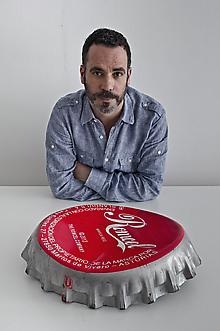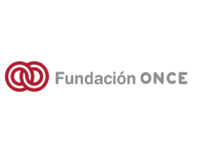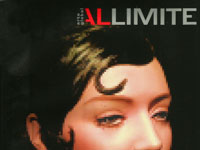
Rómulo Celdrán
Spanish artist Rómulo Celdrán (b. 1973) brings exquisite technical skill, a fastidious eye, and a scientific attention to detail to both his mixed-media drawings on board and his larger-than-life sculptures of quotidian objects. His works place him firmly within the trajectory of Photorealism while offering a new take on the fetishistic esthetic of Pop Art, engaging in particular with Claes Oldenburg’s playfully monumental sculptures. But rather than existing exclusively as impersonal objects, Celdrán integrates a subtle human presence—implied, but never obvious—into his drawings and sculptures: the bottle cap has been pried off; the ice cube tray was filled and spilled; the pencil was recently sharpened.
In the ongoing series Zoom, Celdrán focuses with laser-beam intensity on the intimate features of everyday items and materials that are usually overlooked by the human eye. Marked by a masterful command of light, texture, and form, these acrylic and pencil drawings are monochromatic, featuring a limited palette of white, gray, and black. Eschewing the potential distraction of vibrant color, Celdrán’s minutely observed, almost archival black-and-white representations of reality showcase the complexity and nuances of each object, allowing it to sing on its own. Drawing viewers in close, the works reward careful looking with meticulously rendered reflections, shadows, and shades.
Macro, on the other hand, aptly describes Celdrán’s singular, hand-constructed sculptures of exaggerated scale. Though these blown-up pen caps, kitchen sponges, and spilled cans of paint may, at first glance, recall Oldenburg’s approximations of Pop culture icons and symbols, they have more in common with Celdrán’s own works on paper. Like his drawings, these sculptures offer similarly studied, anthropological explorations of the minute details of every object he selects for exploration—this time in three-dimensions. Further overturning viewers’ expectations, and forcing them to look again at something they assume they already know, Celdrán always uses unexpected materials. His sculpture of a metal bottle cap, for example, is made of resins and polyurethanes; the ice cube tray is not comprised of plastic; the hot-water bottle is not made of rubber. Never made from a mold, each work is absolutely unique. Nothing is what it seems, as distortions of scale allow the artist to plumb the physical and material reality of our world in a more focused, concentrated capacity.
In 2010, Rómulo Celdrán’s work was included in Europe’s most important exhibition on Realism in last half century, Realismus – das Abenteuer der Wirlichkeit, at the Kunsthalle Der Hypo-Kulturstiftung Museum in Germany and Kunsthal Rotterdam, Amsterdam. The exhibition placed Celdrán’s works alongside masters: Gustav Courbet, Edouard Manet, Walker Evans, Richard Estes, Gerhard Richter, Charles Bell, Thomas Ruff, Andreas Gursky, Alfred Eisenstaedt, Edward Hopper, Thomas Struth, Duane Hanson, Chuck Close, and Robert Longo.
Works by Celdrán are held in esteemed public and private collections such as the Art Collection HypoVereinsbank, Germany; Artphilein Foundation, Liechtenstein; Artium Museum, Spain; Beth Rudin DeWoody Collection, USA; The National Library of Spain, Spain; Biedermann Museum, Germany; Caja Madrid Collection, Spain; Genty Latimer Collection, United Kingdom, and Testimonio Collection, LaCaixa, Spain.
Rómulo Celdrán is represented exclusively by Hasted Kraeutler in the United States.

